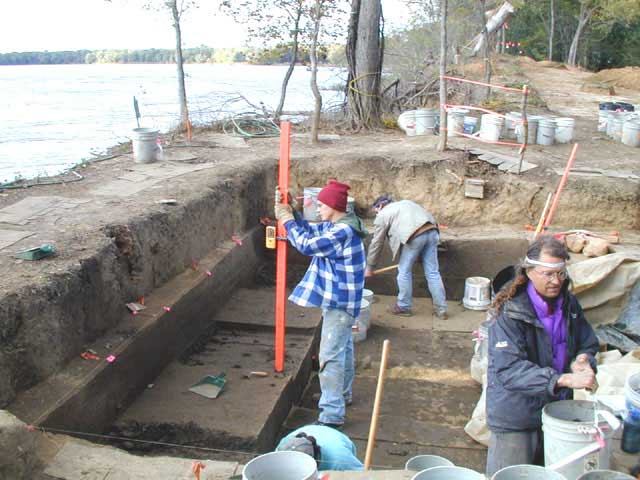Bone Bank Archaeological Research
Posey County, Indiana
Rescue Excavations at the Bone Bank Archaeological Site in Southwestern Indiana
 Introduction
Introduction
 Indiana's First Archaeological Excavation
Indiana's First Archaeological Excavation
 Survey and Testing
Survey and Testing
 Significance
Significance
 Project Goals
Project Goals
 Research Stages
Research Stages
 Expected Results
Expected Results
 Bone Bank in 2000
Bone Bank in 2000
 Planning for 2001
Planning for 2001
 Current Work
Current Work
 In the News
In the News
 Fall 2001 Lecture
Fall 2001 Lecture
 References
References
 Geomorphological History
Geomorphological History
 Links
Links

October 1 to 26, 2001 (Part 2)
As temperatures dropped, the always wet and dirty water-screening job became more of a chore. Stirring the water-soaked excavated soil to dissolve the clods was sometimes best done with shovels.

Don Bialkowski marks the target excavation depth in Unit 5C, L.7, using the laser level receiver that is on the orange rod. When Prof. Patrick Munson lent his hand to help with rescue excavations, he came up with the idea of using the pointed end of the rod to auger down to the target elevation. The archaeologist can then excavate down to the bottom of the augered holes and even out the bottom of the unit at the precise depth.

Because of rain over much of Indiana and Illinois, the Wabash River was rising during our last 2 weeks of work. We monitored river levels with a stake placed in the river bank at a known depth.

Bone Bank 2001, aerial view of South Blocks 1 and 2.

South excavation Blocks 1 and 2 were backfilled on October 26, 2001, as the river continued to rise. The same day, WNIN, the National Public Radio station in Evansville, aired an interview about the Bone Bank project

The excavated collection has been packed and delivered to Indiana University, Bloomington, where washing, cataloging, and analysis have begun. Report writing will follow.
Previous Weeks
First Week (August 22-26, 2001)
Second Week (August 29 - September 2, 2001)
Third Week (September 5 - September 9, 2001)
Fourth Week (September 12 - September 16, 2001)
Fifth Week (September 19 - September 23, 2001)
Sixth Week (September 26 - September 30, 2001)
October (October 1 - October 26, 2001) Part 1
October (October 1 - October 26, 2001) Part 2
Thanks Everyone!
Current Week
Return to Top
Last updated on 9/17/2001
Send Comments to: munsonc@indiana.edu
Site sponsored by Indiana University
 Introduction
Introduction
 Indiana's First Archaeological Excavation
Indiana's First Archaeological Excavation
 Survey and Testing
Survey and Testing
 Significance
Significance
 Project Goals
Project Goals
 Research Stages
Research Stages
 Expected Results
Expected Results
 Bone Bank in 2000
Bone Bank in 2000
 Planning for 2001
Planning for 2001
 Current Work
Current Work
 In the News
In the News
 Fall 2001 Lecture
Fall 2001 Lecture
 References
References
 Geomorphological History
Geomorphological History
 Links
Links





